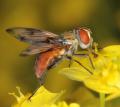Diptera.info :: Family forums :: Syrphidae
Who is here? 1 guest(s)
|
Chrysotoxum festivum?, ♀? --> yes but male
|
|
| kuv |
Posted on 03-06-2022 10:18
|
|
Member Location: Schenefeld near Hamburg Posts: 3784 Joined: 30.04.10 |
Northern Germany, Schleswig-Holstein, Halstenbek near Hamburg, found in area of tree nursery, earthwall (overgrown with small bushes like hazel, maple, roses, sloes, brambles) under big oaks, at a leaf of Ligustrum sp.; Outside-Photos: kuv, 2nd of June 2022. Is my idea - after checking the Diptera Gallery - ok? Please help to get the ID. Kuv kuv attached the following image:  [115.91Kb] Edited by kuv on 06-06-2022 09:57 |
|
|
|
| kuv |
Posted on 03-06-2022 10:18
|
|
Member Location: Schenefeld near Hamburg Posts: 3784 Joined: 30.04.10 |
2nd picture:
kuv attached the following image:  [158.89Kb] |
|
|
|
| Sundew |
Posted on 04-06-2022 14:03
|
|
Member Location: Berlin and Baden-Württemberg, Germany Posts: 3938 Joined: 28.07.07 |
First: it's a male, the eyes touch. Second: the gallery is a great instrument, but you must know what characters to check. It is much more informative to search the forum archive for Chrysotoxum threads and read the explanations why this species and not that. Having said this, if you use a Chrysotoxum key, e.g., tha one by Van Veen (https://books.goo...&hl=de), you find that the first character to be checked is the size relation of the three antenna segments. A good close look to the antenna is important for Chrysotoxum ID. Well, I guess that the 3rd segment is rather short. So you will eventually reach the species couple Chrysotoxum festivum and C. vernale. To tell them apart you have to decide if the femora 1 and 2 are completely yellow or have a black base. Your photos don't show that. Luckily, Falk (https://www.flick...084890357/) writes that in C. vernale "the stripes on the tergites are yellower and straighter (not curved at their outer ends)". In https://www.insek...x?ID=65398 is also pointed out that the flight times differ. C. vernale is said to fly in late April, C. festivum starts a month later. However, I saw a C. vernale at the end of May... To sum it up: your male has stripes that are curved at the outer end and flies in June, which is a strong indication for C. festivum. That is the best I can say. I always recommend Steven Falks Syrphidae collections (https://www.flick...614727117/) - the pictures are excellent, and the decisive characters are given. Of course, not all species that occur in Germany are covered, but Schleswig-Holstein is close to Great Britain  . .Regards, Sundew |
|
|
|
| kuv |
Posted on 06-06-2022 09:55
|
|
Member Location: Schenefeld near Hamburg Posts: 3784 Joined: 30.04.10 |
Wooow, thank you very much, Sundew  for your great informative fundamental reply. for your great informative fundamental reply.Greetings Kuv |
|
|
|
| Jump to Forum: |













